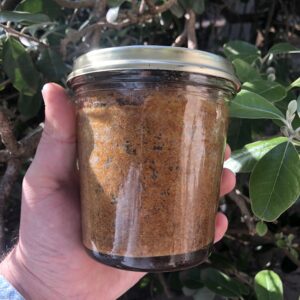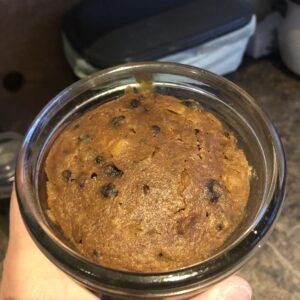I like making preserves because I like cooking and I like science. It also satisfies that weird self-sufficiency kick that comes from being raised by hippy parents, and preserving using Fowlers jars also means I get to keep an eye out for interesting jars when we’re in junk shops. It’s all my hobbies in one, plus the promise of food!
First, some context. Anything you buy in a can in a shop is a preserve, along with things like jams, chutneys and pickles. So long as the container is sealed and the proper technique followed, the food inside cannot be attacked by bacteria and do not need refrigeration.
In a time before refrigeration – most of human history – being able to preserve fresh food for later was vital. Australia, like most countries, have their own home-grown brand of preserving products. America has Mason Jars, the French have Le Parfait, and we have Fowlers Vacola. Fowlers produced recipe books to compliment their products, and for decades they were an integral part of Australian home life.
One advantage of the Fowlers system over some others is that the lids are completely reusable – it’s just the plastic seals that get disposed of when they wear out. The jars themselves are also incredibly common second-hand. They really did make hundreds of thousands of them, and it’s not hard to find them online, in antique stores, at garage sales, in charity shops, and so on. Fowlers still make jars today, which means there are a healthy supply of lids and seals, but you could easily argue that through using second hand jars rather than buying new ones your hobby is much less resource intensive and has a much lower environmental impact.
Also, because Fowlers have been around for so long they also made some pretty weird stuff! One is a series of jars especially for making and preserving your own puddings. Enter the #28 jar.
The #28 Jar

Fowlers jars are designated with a number. This is very helpful. The Size 28, 42 and 56 jars are all “tapered” designs taking a 4 1/4 inch lid, and they were designed for making puddings. The tapered design made it easier to wiggle your pudding out.
Any company that puts this much thought into pudding is alright by me.
The #28 jar is considered one of the rarer models. You see them, but not too often – if you believe eBay, they’re worth stacks of cash but if you casually keep an eye out you’re sure to find one. They went out of Production 2006, so second hand is your only option. Additionally, the 4 1/4 inch lid is a weird one – they need that extra 1/4 inch for the taper, and while they still make these lids today they’re so specific they’re kinda pricey. A 4 1/4 inch stainless steel lid did exist at one stage, but has been out of production for a good long while and so they seem to be particularly expensive second hand.
I’ve picked up three #28 jars through casual junk shop rummaging over the years, which means I can make three puddings whenever I want. Take that, Big Pudding.
The Recipe
Though modern Fowlers recipe books do not include a pudding recipe, the old ones do. The following notes for puddings comes from the 20th Revised Edition –
Although the production of the following Jars has been discontinued, if you have these jars you may use the No. 8 Jelly Jar for a ½ lb. Pudding the ½ lb. Meat Mould for a ¾ lb. Pudding, and the No. 39 Tapared Bottle for a 2 lb. Pudding or you may use the two bottles which are still readily Available, the No. 28 Tapared Bottle for a 1 ¼ lb. Pudding, and the No. 42 Cylinder Bottle for a 2 lb. Pudding.
Place Rings on Bottles. Make the pudding to your own recipe, or use the recipe on this page. Put mixture in Bottles, allowing plenty of room for the Pudding to swell.
When using the No. 8. Jelly Jar or ½ lb. Meat Mould, fill to within ½ inch of the top.
When using the No. 28 Bottle, fill to within 1 inch of the top.
When using the No. 39 or No. 42 Bottle, fill to within 1 ½ inches of the top.
Place Covers and Clips on Bottles.
Bring to boiling point (210-212 degrees) and hold at boiling point for 4 hours.
Recipe for Plum Pudding
½ lb currents
½ lb currants
½ lb Raisins
½ lb Sultanas
6 Oz Suet
6 Oz Breadcrumbs
6 Oz Sugar
½ lb self raising flour
2 eggs
6 oz mixed peel
½ oz mixed spices
½ lb treacle
1 pint milk (the Milk may be reduced a little and 1 or 2 tablespoons of Brandy added, if desired)
Mix dry ingredients together. Add Eggs, Treacle, and then Milk, or Milk and Brandy. Stir Well.
Page 126-127, Fowlers Method of Bottling Fruits and Vegetables, Twentieth Revised Edition.
The same book also includes a recipe for Brandy Sauce, which I’ve not tried, but which looks pretty good!
A delicious Brandy Sauce, which does not require sterilising, can be made just prior to serving the Plum Pudding, from the following recipe:
¼ Cup Brandy
1 Teaspoon Corn Flour
1 Egg Yolk
1 ½ Tablespoons sugar
½ Pint Milk
½ oz Butter
Mix together and boil for five minutes.
Page 128, Fowlers Method of Bottling Fruits and Vegetables, Twentieth Revised Edition.
Okay, so! That’s our primary source. The next step is to convert the recipe to metric, as follows.
- 225g Currants
- 225g Raisins
- 225g Sultanas
- 170g Suet
- 170g Breadcrumbs
- 170g Sugar
- 225g self raising flour
- 2 eggs
- 170g mixed peel
- 15g mixed spices
- 225g treacle
- 600ml milk
Through experience I can tell you that this recipe makes enough for six size 28 jars, accommodating the requisite 1 inch (2.5cm) of room at the head of the jar. Not everyone has six #28 jars, so I’ve made the following table to help scale the recipe down to however many jars you have.
| 6 | 5 | 4 | 3 | 2 | 1 | |
| Currants (grams) | 225 | 190 | 150 | 115 | 75 | 40 |
| Raisins (grams) | 225 | 190 | 150 | 115 | 75 | 40 |
| Sultanas (grams) | 225 | 190 | 150 | 115 | 75 | 40 |
| Suet (grams) | 170 | 140 | 115 | 85 | 55 | 30 |
| Breadcrumbs (grams) | 170 | 140 | 115 | 85 | 55 | 30 |
| Sugar (grams) | 170 | 140 | 115 | 85 | 55 | 30 |
| Self Raising Flour (grams) | 225 | 190 | 150 | 115 | 75 | 40 |
| Eggs | 2 | 2 | 2 | 1 | 1 | 1 |
| Mixed Peel (grams) | 170 | 140 | 115 | 85 | 55 | 30 |
| Mixed Spices (grams) | 15 | 15 | 10 | 10 | 5 | 5 |
| Treacle (grams) | 225 | 190 | 150 | 115 | 75 | 40 |
| Milk (ml) | 600 | 500 | 400 | 300 | 200 | 100 |
I used the above scale to make 3 puddings following the directions of the original recipe above, and they worked out alright! Please pay special attention to the four hours of boiling – this is important. I get the impression that old Fowlers recipes were a bit overzealous in their recommended times, but giving your pudding isn’t going to suffer from being boiled for too long it’s hard to justify skimping on the effort in this area.
One note I can add is to use butter or margarine to cover the internal walls and bottom of of the jar (like you’re greasing a cake tin) before you add the pudding mix – this will help you ease the pudding out later. You should also be aware that suet is animal fat from the kidneys of a cow or a sheep, and as such the original recipe is not suitable for vegetarians. As my partner is vegetarian, I replaced suet with Copha, a vegetable shortening made of coconut oil that’s quite common here in Australia, but you could use another vegetable shortening, butter or margarine.

My technique to serve the pudding is to open the jar (careful not to damage the weirdly expensive 4 1/4 inch lid), turn it upside down on a plate, and microwave it for 2 minutes. The pudding falls out of the jar, lovely and warm, and then I slice it into four pieces and pop each portion in a bowl with a bit of warm custard. A quick and convenient desert that you made yourself, just perfect for a rainy evening.
I hope this has helped encourage you to perhaps put your No. 28 Fowlers Jar to good use! Why not?
Other links:
- This Article from Darling Downs Diaries is one of the few I could find online from anybody still making puddings in Fowlers jars today. In their case they use a Size 31 jar and a different recipe, but it seems to work just fine!
- Is it safe to make steamed puddings in your Fowlers Jars? The question is really about if steamed puddings in general are safe – and, unsurprisingly, there’s quite a bit of research! This article from the Institute of Food Science and Technology covers it off. In a word, yes it is safe – and, additionally, they haven’t killed me yet.
- Fowlers Vacola still exist today, and their products can still be found in supermarkets all around Australia